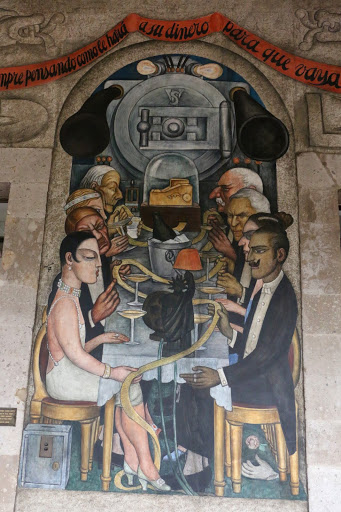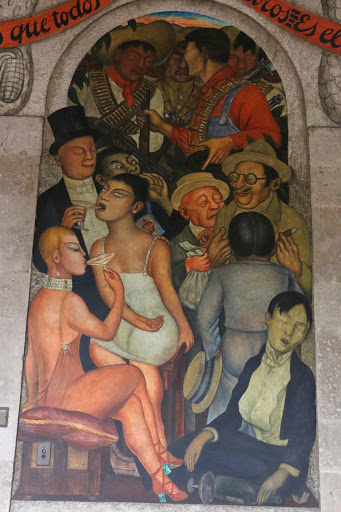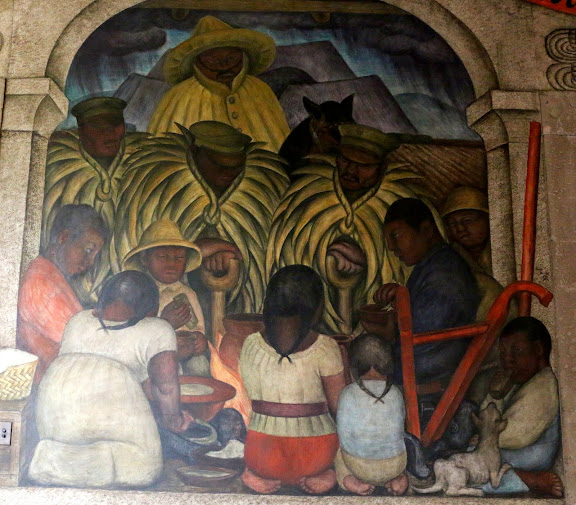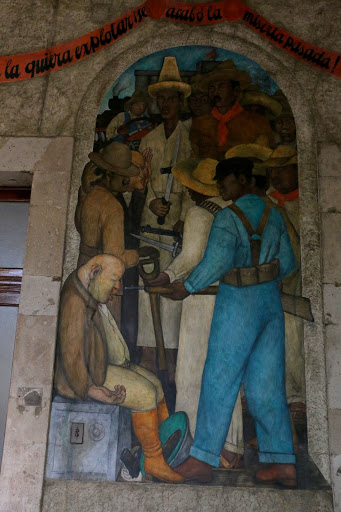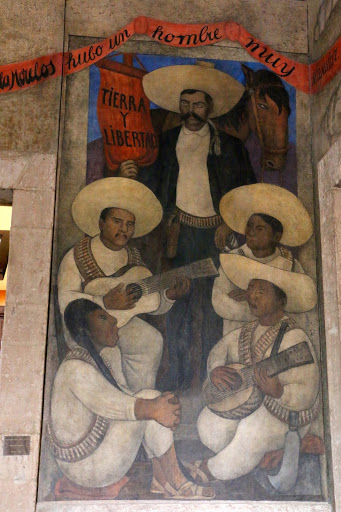Confronting the Daunting National Palace
We admit it. Although we initiated our Ambles around the City in the Zócalo, the huge plaza in Centro Histórico that is the heart of Mexico City, we have stayed away from the National Palace dominating its east side. Similarly, we had stayed away from the Metropolitan Cathedral, on its north side, until we were able to come to terms with, and write about Mexican Baroque architecture, of which the inside of the Cathedral is the quintessential example.
Like the Cathedral, the National Palace is intimidating in its grandeza, grandeur, and off-putting because of its associations with the history of Mexican authoritarian governments. The fact that this symbolic center of Mexican democracy is called a palace is indicative of the paradox of Mexican government: is it, or is it not, a democracy?
 |
| The Palace—first of Cortés, then the Spanish Viceroy, then of the Mexican government—has been rebuilt and expanded many times over nearly 500 years. The third story was added in the 1920s, after the Mexican Revolution. |
Nevertheless, as we were recently publishing some posts on Diego Rivera and Frida Kahlo borrowed from our spouse, Jane's "Jenny's Journal of Mexican Culture", we decided it was time to cross the threshold into the Palace to see Rivera's mural of the History of Mexico. We had also read that one could see through a window on the floor a part of what was once the private prayer room of Moctezuma the Younger in what had been his "New Houses". After destroying the house of Moctezuma, Cortés built the Palace on that site.
At the Center of Mexico's Heart, Tranquility
Visitors to the Palace enter via a side door on the north side, on Moneda (Coin) Street (the former mint was just behind the Palace). We had often glimpsed the inner courtyard as we passed by on our way to other destinations in East Centro. It looked inviting. When we finally enter, we find a beautifully landscaped, tranquil garden, an oasis in the very center of the City's bullicio, hubbub.
 |
| Inner courtyard, in the rear of the Palace. |
 |
| Formal, front courtyard, used for Presidential speeches and other formal events. Rivera murals are in the stairwell from this courtyard and on the second floor. |
Diego Rivera's Vision of Mexico's Complex and Complicated History
Part I: The Violent Spanish Conquest (1519-21)
 |
| Starting from the left, we see Spanish soldiers and some of their indigenous allies attacking Jaguar Warriors, an elite Aztec/Mexica corps. |
 |
| Middle portion of the Conquest section of the mural. We are viscerally struck by the military and cultural differences between the Spanish cavalry and indigenous warriors in symbolic garb. |
 |
| Right-hand portion of the Conquest section. Rivera pulls no punches in portraying the violence of the Conquest. |
Part II: Life in Spanish Colonial New Spain (1521-1823)
 |
| "Reading" from the left, across the middle band we see portrayals of Colonial Nueva España, New Spain. At left, an indigenous man is branded as a slave. At right, the Franciscan Diego de Landa Calderón burns Mayan books in the Yucatán. Above them, indigenous workers build Nueva España, New Spain, for the Spanish. |
 |
| Next, under a canopy, the Viceroy and the Archbishop oversee autos de fe, trials and executions of supposed heretics, i.e., persons not maintaining the Catholic Faith. |
 |
| In the fourth scene (we'll return to the third shortly), Spanish friars carry out the conversion and baptism of the indigenous peoples, the so-called Spiritual Conquest whose vestiges we have been exploring in many posts on the Original Indigenous Villages of Mexico City. |
 |
| In the fifth scene, indigenous men labor as virtual slaves in the mines. Mexican silver financed the expansion of Spanish power in Europe. |
 |
| In the third, middle, scene, at the center of the grand mural, Father Miguel Hidalgo, proclaims the War for Independence from Spain. Immediately to the left of Hidalgo is Ignacio Allende (in Spanish Army uniform); to the right is Jose María Morelos, who took leadership of the rebellion after Hidalgo and Allende were captured and executed. Far left, with red crown, is Agustín Iturbide, Spanish Army general who joined the almost elimnated rebels in 1821, defeated the Spanish, and had himself declared Emperor of Mexico. To the right of Iturbide is Guadelupe Victoria (in red vest, holding the Mexican flag), a rebel who, after Iturbide was deposed, became the first President of Mexico. The other figures are other persons who played roles in the War, but their identification is beyond us. |
Part III: Mexico of the 19th and early 20th Centuries
The top row of the mural, under the arches, portrays scenes from 19th and 20th century Mexican history, primarily one of foreign army interventions (the U.S. and France), and civil wars between wealthy conservatives—supporting the privileges and powers of the Army and the Catholic Church—and liberals seeking a democratic, egalitarian government (the mid-19th century War of Reform and the early 20th century Mexican Revolution). For some reason, Rivera did not not present them in chronological order. He placed the Mexican Revolution at the center, above the War for Independence. We present them in historical order, to make the story more comprehensible to extranjeros, foreigners.
 |
| Defense of Chapultepec Castle from U.S. forces in 1847 during the War of the U.S. Intervention (aka Mexican-American War in the U.S.). It is the American eagle arriving, holding arrows in its claws. The fall of the castle, which served as the military academy, was the last battle in the U.S. capture of Mexico City. President James Polk intitiated the war to gain California from Mexico, which had refused to sell it. So, losing the war, Mexico's was forced to surrender half of its territory, virtually all of the currnent U.S. Southwest and west. |
 |
| Benito Juárez and the Laws of Reform Conservative President Santa Ana, a Spanish Army general who had joined Iturbide to win the War of Independence, but then joined the rebellion to overthrowm him as Emperor, had been president several times since 1833. He had lost Texas in 1836 and the War of the U.S. Intervention in 1847, and had gone into exile abroad each time. Nevertheless, he was called back from exile by conservatives to be president once again in 1853 to oppose a liberal uprising. In 1855, liberal forces succeeded in deposing him. They established a new government and issued a series of Laws of Reform, mostly written by Benito Juárez, a lawyer and President of the Supreme Court ( the moreno, dark-skinned Zapotec indigenous man, holding laws in his hand). These laws took autonomous power from the Army and property from the Catholic Church. (Note fat friar, Army general and Bishop, and others with their hands in the kitty.) In 1857, conservative generals, in turn, overthrew the liberal govenment. Upon the surrender of liberal president, Ignacio Comonfort, Juárez became president. He took the government to various cities in Mexico and engaged in the War of Reform (1857-61). Defeating the conservatives at the end of 1860, Juárez and his government returned to Mexico City on Jan. 1, 1861. Figures on each side of Juárez are other persons in the Reform Period (1855-1876). |
 |
| The French Intervention 1861-1867 In reaction to the liberal victory in the War of Reform, conservatives went to Emperor Napoleon III of France and asked that he select some European royal to become Emperor of Mexico. Prince Ferdinand Maximilian Joseph of Austria, younger brother of Emperor Franz Joseph I, accepted Napoleon's offer and came to Mexico to become Emperor Maximillian I. The liberals, led by Juárez, waged war against him. In 1866, Napoleon, under pressure from the U.S. and others factors in Europe, withdrew French troops, leaving Maximillian with only the support of conservative Mexican generals and their troops. The next year, in mid-May 1867, Maximilian (red-haired, bearded figure, far right) was captured and executed a month later. . Mexican conservative Generals Miguel Miramón and Tomás Mejía were executed with him. The fleeing eagle is evidently that of the Austrian Empire. |
 |
| Mexican Revolution (1910-1917) President and dictator Porfirio Díaz (1876-1911), (at left, in military uniform, many medals and presidential sash) was overthrown by forces led by Francisco Madero (light-skinned, bearded man, wearing presidential sash, right of center). Madero was overthrown and assassinated in Feb. 1913, by Victoriano Huerta (military figure, at right of Díaz, wearing presidential sash). Then, Venustiano Carranza (white-bearded figure, wearing presidential sash, lower right), Pancho Villa (dark-skinned figure in sombrero behind Carranza), and Emiliano Zapata (mustached figure in sombrero, upper right) waged war to overthrow Huerta in 1914. Carranza subsequently fought and defeated Villa and Zapata, becoming President in 1917, and ending the formal series of wars. |
 |
| Mexican Revolution and Beyond In 1920, Carranza was overthrown and assassinated by his former general, Álvaro Obregón, because Carranza overlooked him in choosing a successor. In 1924, Plutarco Calles (far left figure holding eagle standard) became president. After the assassination of Obregón, who had been reelected president in 1928, Calles maintained power as "chief boss." In 1934, Lázaro Cárdenas (at right of Calles, wearing presidential sash) became president and sent Calles into exile. The mural was finished in 1935, just after Cárdenas took power. He was seen as a liberal, even socialist, who implemented many of the labor and land reforms sought by the Revolution and written into the new Constitution of 1917, but not carried out. In back, Emiliano Zapata (killed by agents of Carranza in 1919) and an industrial worker in blue overalls, hold the banner "Land and Liberty". This represents Rivera's hope for a true, communist revolution, such as he portrayed in his mural, "Ballad of the Revolution" in the Secretariat of Education. |
Rivera's Vision of a True, Marxist-Communist Revolution
The Mexican Revolution was a very ambiguous series of conflicts between los de abajo, those from below (represented by Pancho Villa and Emiliano Zapata) and los de arriba, those from above, represented by Carranza). The outcome was, likewise, ambiguous. Carranza became president, but was forced to accept a Constitution that included a list of "rights", such as to work and an education, sought by the popular forces. Much power, however, was given to the president, such that, despite a Congress and a Supreme Court, he could essentially ignore the liberal articles of the Constitution.
Like many other Mexican artists and intellectuals, Rivera was a communist and was disappointed by the authoritarian path the post-revolution government was taking. (In 1936, he painted a mural entitled "The Dictator", in which he portrayed Calles as a Fascist; the mural is now in Bellas Artes.) He continued to hope for a real revolution of the agrarian and working class that would overthrow the capitalist powers. As he had done in his "Ballad of the Revolution", here in the National Palace, the very seat of government, in the stairway to the left of The History of Mexico, he also painted a vision of that hope.
 |
| Call for a Communist Revolution of Workers (hammer) and Farmers (sickle), suppressed by soldiers wearing gas masks (like those used in World War I) |
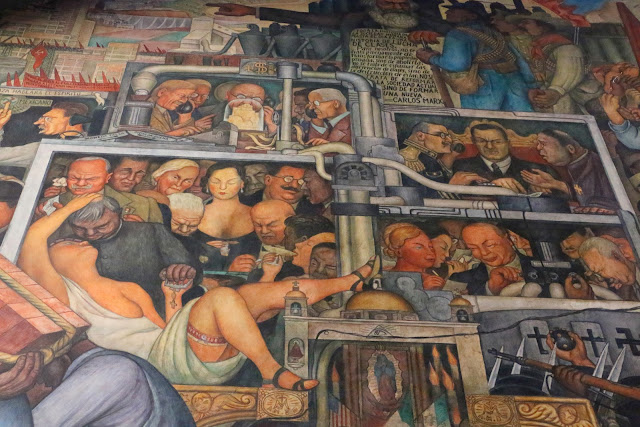 |
| Corrupt, immoral Capitalist Class, focused entirely on money (scrutinizing stock market ticker tape, upper left). Note the priest, engaged with a prostitute, at left. |
Needless to say, Rivera's vision was never realized in Mexico. Led by Calles and then Cárdenas, the Party of the Institutional Revolution (PRI) (an oxymoron of a name) consolidated power into a one-party political system, not unlike what also actually happened in Russia. This system lasted until 2000, when Vicente Fox of the National Action Party won the presidency. However, the PRI returned to power in 2012, led by Enrique Peña Nieto. The mixture of democratic forms with authoritarian ways of operating, which goes all the way back to the beginning of an independent Mexico, is ongoing.






